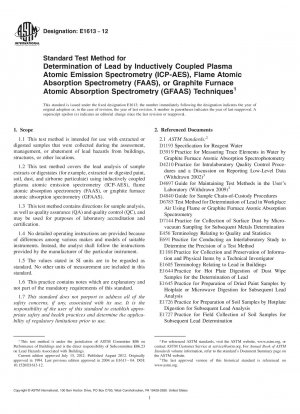ASTM E1613-12
Standard Test Method for Determination of Lead by Inductively Coupled Plasma Atomic Emission Spectrometry (ICP-AES), Flame Atomic Absorption Spectrometry (FAAS), or Graphite Furnace Atomic Absorption Spectrometry (GFAAS) Techniques
- Standard No.
- ASTM E1613-12
- Release Date
- 2012
- Published By
- American Society for Testing and Materials (ASTM)
- Latest
- ASTM E1613-12
- Scope
This test method is intended for use with other standards (see 2.1) that address the collection and preparation of samples (dried chips, dusts, soils, and air particulates) that are obtained during the assessment or mitigation of lead hazards from buildings and related structures.
This test method may also be used to analyze similar samples from other environments.
1.1 This test method is intended for use with extracted or digested samples that were collected during the assessment, management, or abatement of lead hazards from buildings, structures, or other locations.
1.2 This test method covers the lead analysis of sample extracts or digestates (for example, extracted or digested paint, soil, dust, and airborne particulate) using inductively coupled plasma atomic emission spectrometry (ICP-AES), flame atomic absorption spectrometry (FAAS), or graphite furnace atomic absorption spectrometry (GFAAS).
1.3 This test method contains directions for sample analysis, as well as quality assurance (QA) and quality control (QC), and may be used for purposes of laboratory accreditation and certification.
1.4 No detailed operating instructions are provided because of differences among various makes and models of suitable instruments. Instead, the analyst shall follow the instructions provided by the manufacturer of the particular instrument.
1.5 The values stated in SI units are to be regarded as standard. No other units of measurement are included in this standard.
1.6 This practice contains notes which are explanatory and not part of the mandatory requirements of this standard.
1.7 This standard does not purport to address all of the safety concerns, if any, associated with its use. It is the responsibility of the user of this standard to establish appropriate safety and health practices and determine the applicability of regulatory limitations prior to use.
ASTM E1613-12 Referenced Document
- ASTM D1193 Standard Specification for Reagent Water
- ASTM D3919 Standard Practice for Measuring Trace Elements in Water by Graphite Furnace Atomic Absorption Spectrophotometry
- ASTM D4210 Standard Practice for Intralaboratory Quality Control Procedures and a Discussion on Reporting Low-Level Data
- ASTM D4697 Standard Guide for Maintaining Test Methods in the User's Laboratory
- ASTM D4840 Standard Guide for Sample Chain-of-Custody Procedures
- ASTM D6785 Standard Test Method for Determination of Lead in Workplace Air Using Flame or Graphite Furnace Atomic Absorption Spectrometry
- ASTM D7144 Standard Practice for Collection of Surface Dust by Micro-vacuum Sampling for Subsequent Determination of Metals and Metalloids
- ASTM E1188 Standard Practice for Collection and Preservation of Information and Physical Items by a Technical Investigator
- ASTM E1605 Standard Terminology Relating to Lead in Buildings
- ASTM E1644 Standard Practice for Hot Plate Digestion of Dust Wipe Samples for the Determination of Lead
- ASTM E1645 Standard Practice for the Preparation of Dried Paint Samples by Hotplate or Microwave Digestion for Subsequent Lead Analysis
- ASTM E1726 Standard Practice for Preparation of Soil Samples by Hotplate Digestion for Subsequent Lead Analysis
- ASTM E1727 Standard Practice for Field Collection of Soil Samples for Lead Determination by Atomic Spectrometry Techniques
- ASTM E1728 Standard Practice for Field Collection of Settled Dust Samples Using Wipe Sampling Methods for Lead Determination by Atomic Spectrometry Techniques
- ASTM E1729 Standard Practice for Field Collection of Dried Paint Samples for Lead Determination by Atomic Spectrometry Techniques
- ASTM E1741 Standard Practice for Preparation of Airborne Particulate Lead Samples Collected During Abatement and Construction Activities for Subsequent Analysis by Atomic Spectrometry
- ASTM E1775 Standard Guide for Evaluating Performance of On-Site Extraction and Field-Portable Electrochemical or Spectrophotometric Analysis for Lead
- ASTM E1792 Standard Specification for Wipe Sampling Materials for Lead in Surface Dust
- ASTM E1864 Standard Practice for Evaluating Quality Systems of Organizations Conducting Facility and Hazard Assessments for Lead in Paint, Dust, Airborne Particulate, and Soil in and around Buildings and Related Structures
- ASTM E1979 Standard Practice for Ultrasonic Extraction of Paint, Dust, Soil, and Air Samples for Subsequent Determination of Lead
- ASTM E2239 Standard Practice for Record Keeping and Record Preservation for Lead Hazard Activities
- ASTM E456 Standard Terminology for Relating to Quality and Statistics
- ASTM E691 Standard Practice for Conducting an Interlaboratory Study to Determine the Precision of a Test Method
ASTM E1613-12 history
- 2012 ASTM E1613-12 Standard Test Method for Determination of Lead by Inductively Coupled Plasma Atomic Emission Spectrometry (ICP-AES), Flame Atomic Absorption Spectrometry (FAAS), or Graphite Furnace Atomic Absorption Spectrometry (GFAAS) Techniques
- 2004 ASTM E1613-04 Standard Test Method for Determination of Lead by Inductively Coupled Plasma Atomic Emission Spectrometry (ICP-AES), Flame Atomic Absorption Spectrometry (FAAS), or Graphite Furnace Atomic Absorption Spectrometry (GFAAS) Techniques
- 1999 ASTM E1613-99 Standard Test Method for Determination of Lead by Inductively Coupled Plasma Atomic Emission Spectrometry (ICP-AES), Flame Atomic Absorption Spectrometry (FAAS), or Graphite Furnace Atomic Absorption Spectrometry (GFAAS) Techniques
